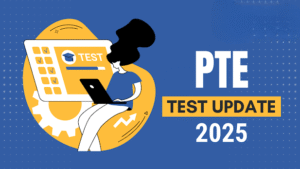
If you’re preparing for the PTE Academic, then you must know that the PTE updates in 2025 introduce significant changes you can’t afford to ignore. On 7 August 2025, Pearson officially launched a new version of the test, bringing PTE new features, updated question types, and a refreshed test experience.
These changes are designed to reflect real-world communication, improve fairness, and reward more spontaneous and relevant responses. At the same time, they also mean your preparation strategy needs to evolve.
In this article, we’ll break down all the PTE exam changes in 2025, explain how the PTE format changes affect your test-taking, and offer smart PTE test tips for 2025 to help you adapt. These insights will help you navigate the updated PTE with confidence.
Let’s get to know more about them.
What’s Changing in the PTE Format (2025 Edition)
The following changes have been incorporated in the PTE format:-
1. Two New Question Types
Pearson has added two new tasks in the Speaking & Writing module that test your ability to think on your feet and communicate naturally:-
- Summarize Group Discussion: After listening to a 2-4 speaker discussion (roughly 3 minutes), you’ll speak a 2-minute summary, capturing key ideas, opinions, and transitions.
- Respond to a Situation: You will hear and read a scenario (up to 60 words) and then produce a spoken reply for ~40 seconds with relevance and fluency.
With these new PTE question types of 2025, your ability to summarise, analyse, and respond naturally becomes more important than ever.
2. Longer Test and More Tasks
To accommodate the extra content, the test duration has been extended. As of August 7, 2025:-
- The total duration is around 2 hours 15 minutes, up from the previous format.
- The Speaking & Writing section now has 65–75 tasks, compared to the earlier 52–64.
This means more opportunities to demonstrate real-world communication skills, but also more sustained concentration on test day.
3. Hybrid Scoring: AI + Human Oversight
Perhaps the most significant PTE scoring update is the shift to a hybrid model. Responses for some tasks will now be reviewed by human markers in addition to AI.
The tasks now subject to human review are:-
- Summarize Written Text
- Essay Writing
- Describe Image
- Retell Lecture
- Summarize Spoken Text
- Summarize Group Discussion (new)
- Respond to a Situation (new)
AI will continue to evaluate pronunciation and fluency, but human markers will assess content coherence, relevance, and originality, reducing the influence of memorised templates.
This makes the PTE exam changes of 2025 far more meaningful. Your overall ability to think, structure, and communicate authentically is now more valued.
4. Refined Skill Scoring & Rubrics
Pearson has also refined its scoring rubrics so that certain questions now count toward only one skill. This makes scoring clearer and more focused in the following ways:-
- In the new format, Read Aloud contributes exclusively to Speaking, instead of both Speaking and Reading.
- The Summarize Written Text task now uses a 0-4 scale for content, instead of the previous 0-2.
- For essays, criteria like “Structure & Coherence” and “Linguistic Range” are now rated up to 0-6, giving more room to distinguish advanced responses.
This granularity in the PTE scoring updates means it’s easier to identify your strengths and areas for improvement along with making a more targeted preparation plan.
5. UI & Interface Overhaul: Smoother Experience
Pearson has revamped the test interface to make it more intuitive and less stressful. The key changes include:-
- A beep sound before the microphone opens in the “Repeat Sentence” task to alert test-takers when recording begins.
- Improved layout with live audio waveforms, progress indicators, and clearer navigation.
- Removal of optional breaks. The test is now continuous, which can reduce downtime and encourage smoother pacing.
These UI/UX improvements contribute to a better PTE test experience in 2025. This lets you focus more on performance and less on technical distractions.
Why These Updates Were Introduced
Pearson’s underlying goal in these PTE Academic changes is to make the test more aligned with real-life communication, thus, moving away from rote responses toward genuine interaction. As stated in the official 2025 statement, the updates boost relevance, fairness, and authenticity.
Experts agree that the changes encourage more spontaneous speaking and discourage overuse of memorized templates.
With enhanced scoring and evaluation, candidates who apply their language skills more naturally and thoughtfully will likely benefit.
How to Prepare for the New PTE Format (2025)
These updates don’t just demand familiarity. They also require a responsive and evolved study strategy. Here are some PTE preparation 2025 tips to help you adapt to the new format:-
1. Practice the New Tasks Early
- Simulate Summarize Group Discussion by listening to podcasts, lectures, or recorded group conversations.
- Practice Respond to Situation prompts by predicting real-life scenarios, recording, and refining your responses.
2. Adjust Your Mock Tests
- Use updated practice tests that match the new PTE test pattern.
- Time your practice to the extended test duration (~2 h 15 min).
3. Focus on Authentic Responses
- Avoid relying on memorized scripts. Human scoring now rewards genuine ideas and relevance.
- Work on note-taking strategies to summarise effectively in group discussions.
4. Sharpen Repurposed Skills
- For revised scoring, concentrate on single-skill tasks like Read Aloud (speaking), Fill-in (Reading), etc.
- Revisit scoring rubrics to understand how fluency, content, and coherence are graded.
5. Familiarise Yourself with the New Interface
- You must try out familiarisation tools if available. Those are experience waveform visuals, mic beep, and progress bars.
- Consider training under real test conditions with no breaks so you get used to pacing across the longer test.
Impact on PTE Test Takers: What’s Different
With the 2025 updates, PTE test takers will notice several key changes that directly impact how they prepare and perform on exam day. Let’s have a look at them:-
- Templates are riskier: With human review now in key tasks, over-template responses may be penalised.
- Greater challenge in speaking: The new tasks require spontaneous and meaningful responses. Scoring will weigh both content and structure.
- More balanced evaluation: Owing to the presence of clearer skill demarcation and updated rubrics, your weaknesses in one area may be more visible. However, you also get a fairer chance to highlight your strengths.
- Real-world communication tested: These changes reward real-life communicative competence and not just test-specific tricks.
Why These Updates Are Good for Most Applicants
The PTE updates benefit most applicants in the following ways:-
- The PTE’s new features make the test more reflective of everyday academic and professional communication.
- The hybrid scoring system raises validity. Now your content quality matters, not just your speech rhythm.
- With the updated test interface, performance feels more intuitive and less mechanical.
- The test becomes more equitable. Human reviewers discourage formulaic and recycled responses. This can benefit non-native speakers who communicate clearly and meaningfully.
Preparing Specifically If You’re in Brisbane, Australia
If you’re based in Brisbane, Australia, and preparing for PTE in 2025, here’s how you can get ahead:-
- Join IPT Brisbane’s specialized PTE coaching. Our trainers are already training students on the new format.
- Use IPT’s updated mock tests tailored for the updated PTE exam changes 2025.
- Focus on group discussion-style speaking tasks and scenario-response practice. Building these new skills early can give you a significant edge.
Wrapping Up
The Pearson PTE updates 2025 mark a smart evolution in English testing which makes the exam more realistic, more communicative, and less predictable. The new question types, hybrid scoring, and interface changes reward your ability to think, communicate, and respond naturally, rather than relying on memorized patterns.
If you’re preparing for PTE in Brisbane, Australia, you don’t have to navigate these updates alone. IPT Brisbane offers tailored coaching, updated mock exams, and expert-led strategies to equip you for the new PTE test experience in 2025. Let IPT guide you through the transition, sharpen your skills, and help you ace the PTE on its new terms.
Join IPT Brisbane today and stay ahead with the latest PTE preparation for 2025.
Frequently Asked Questions (FAQs)
- What are the new updates for PTE 2025?
The PTE updates 2025 include refined question types, enhanced AI scoring accuracy, improved test security, and minor format adjustments designed to better assess real-world English communication. These changes aim to create a more reliable and fair test experience for all candidates.
- Is PTE getting harder in 2025?
Not necessarily harder, but PTE 2025 is becoming more skill-focused. Templates and memorised responses are now riskier because the AI system has become better at detecting them. This means genuine skill, clarity, and task completion play a bigger role in achieving a high score.
- What is the PTE score system 2025?
The PTE scoring system 2025 continues to use the 10-90 scale but now features improved AI scoring that prioritises pronunciation, fluency, content relevance, and grammar accuracy. The updated system reduces the chances of inflated scores from template-based answers, ensuring a more authentic evaluation of English proficiency.
- How is the PTE 2025 structured?
The PTE 2025 structure still includes Speaking & Writing, Reading, and Listening. However, changes in task weightage, refined scoring rules, and updated question variations make the testing experience slightly more dynamic and reflective of real-world English use.
- What is the syllabus for PTE 2025?
The PTE 2025 syllabus includes all major language skills (speaking, writing, listening, and reading) through tasks such as Describe Image, Retell Lecture, Summarize Written Text, Reading & Writing Fill in the Blanks, Listening tasks, and more. While the core tasks remain the same, updated scoring rules and stricter evaluation on template usage are key changes for test takers to note.
